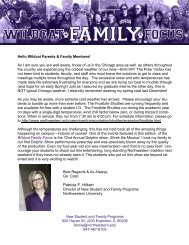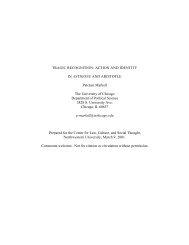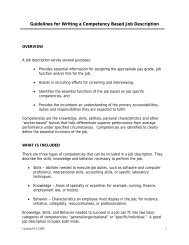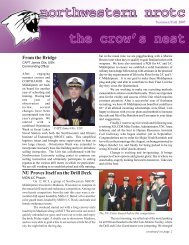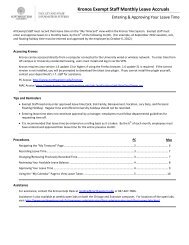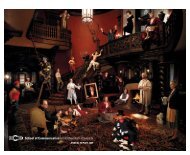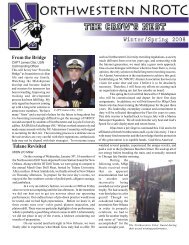Artistry Permits and Custom May Ordain - Northwestern University
Artistry Permits and Custom May Ordain - Northwestern University
Artistry Permits and Custom May Ordain - Northwestern University
Create successful ePaper yourself
Turn your PDF publications into a flip-book with our unique Google optimized e-Paper software.
22<br />
outward marks of social status. A coral house—a sign of permanence <strong>and</strong> economic<br />
confidence—served as a patina for its owner, <strong>and</strong> a family’s coastal ancestry <strong>and</strong> knowledge<br />
of its society were seen as yardsticks Swahili respectability (heshima). The surviving<br />
records show that a man was denied political office if he “had not been long in the country<br />
<strong>and</strong> had no relations there.” 78 Indeed, in most royal succession disputes the “greater <strong>and</strong><br />
lesser mouros,” as described in Sofala, elected an “heir of the l<strong>and</strong>,” so that in the Sofalan<br />
case the nephew of the Sultan became the new ruler. 79 Those having heshima were not<br />
constant as a social group. On the contrary, respect <strong>and</strong> station in society could be won<br />
<strong>and</strong> lost, as witnessed by the fact that lower-status individuals could “Swahilize” by<br />
gaining the physical <strong>and</strong> social trappings of coastal society or conversely “de-Swahilize” by<br />
losing such distinctions. By displaying belongings rich in cultural meaning, such as<br />
prestigious cloth, ungwana defined <strong>and</strong> proclaimed their position in society. 80 In the<br />
fifteenth century, ungwana displayed wealth through personal adornment <strong>and</strong> sumptuous<br />
living in order to concentrate clientele. As circulators of large accumulations of cloth, the<br />
ungwana empowered their political voice to the extent that many successfully challenged<br />
the royalty’s claims to authority or carved out political niches of their own.<br />
Royal personages—generally sultan(a)s, their family, <strong>and</strong> a core of officials—were<br />
the most materially endowed <strong>and</strong> politically powerful figures in Swahili society. 81 Though<br />
78 “Arabic History of Kilwa, c. 1520,” in SD, 85. This aspect of ungwana society was of great importance in the<br />
sixteenth century. Numerous Swahili chronicles demonstrate that remembering a lineage’s history <strong>and</strong> “placing”<br />
a family on the coast from a certain period of time was a strong legitimating factor in its claims to power or<br />
political saliency. For example, Hajj Muhammad Rukn al-Din, the notary of the Sultan of Kilwa’s treasury, was<br />
backed by the Portuguese as the new Sultan of Kilwa in 1505; yet, since he was a recent immigrant <strong>and</strong> had few<br />
familial relations in the town, he had to work very hard to gain the respect of the “principal mouros of the l<strong>and</strong>.”<br />
After his death it was “declared that it was not conducive . . . that such a man of low origin as the son of Mohamed<br />
Ancony [Hajj Muhammad] should reign.” In the end, the cousin of Sultan Ibrahim (the Sultan of Kilwa when the<br />
Portuguese arrived) was favored by the “chief men of the l<strong>and</strong>” as he was “of the royal line of kings who founded<br />
<strong>and</strong> populated the town.” De Barros, 1:liv. 10, cap. 4.<br />
79 “Auto passado por Pero Sobrinho e Diogo Homem, escrivães da feitoria de Sofala, Sofala, 1512 Abril 15,”<br />
DPMAC. 3:244. Sobrinho calls this person “Quyunbe,” or kiyumbe (jumbe?)—an administrative official.<br />
80 After M. Weber’s “Class, Society, Party” in From Max Weber. Eds. H. Gerth <strong>and</strong> C. Mills. New York, 1946. 189.<br />
81 In large city-states like Kilwa, the offices of amir, wazir, <strong>and</strong> qadi were hereditary. See G. Freeman-Grenville, The<br />
Medieval History of the Tanganyikan Coast. Berlin, 1964. Also, it was not uncommon for women to occupy the<br />
office of sultan. Faza <strong>and</strong> Zanzibar both had very famous female rulers <strong>and</strong> there did not seem to be any<br />
restriction against women in powerful state positions anywhere on the coast in this period. J. Str<strong>and</strong>es, The<br />
Portuguese Period in East Africa. In 1615, Nzwani was governed by “an ould woeman Sultanness . . . to whom they<br />
repayre for Justice both in Ciuill <strong>and</strong> Criminall causes.” Three of the Sultana’s children, one of them a woman,<br />
were “Subsultans” at Mwali. William Foster, ed., The Embassy of Sir Thomas Roe. 18. Less than fifty years earlier<br />
(1567-8), the ruler of Domoni had been a man. G. Freeman-Grenville <strong>and</strong> B. G. Martin, “A Preliminary H<strong>and</strong>list<br />
of the Arabic Inscriptions of the Eastern Coast of Africa,” in The Swahili Coast, 2nd to 19th Centuries: Islam,<br />
Christianity <strong>and</strong> Commerce in Eastern Africa. London, 1988. 122.



